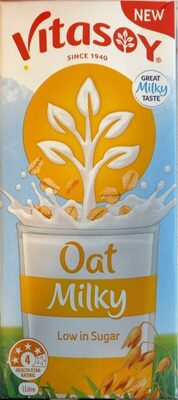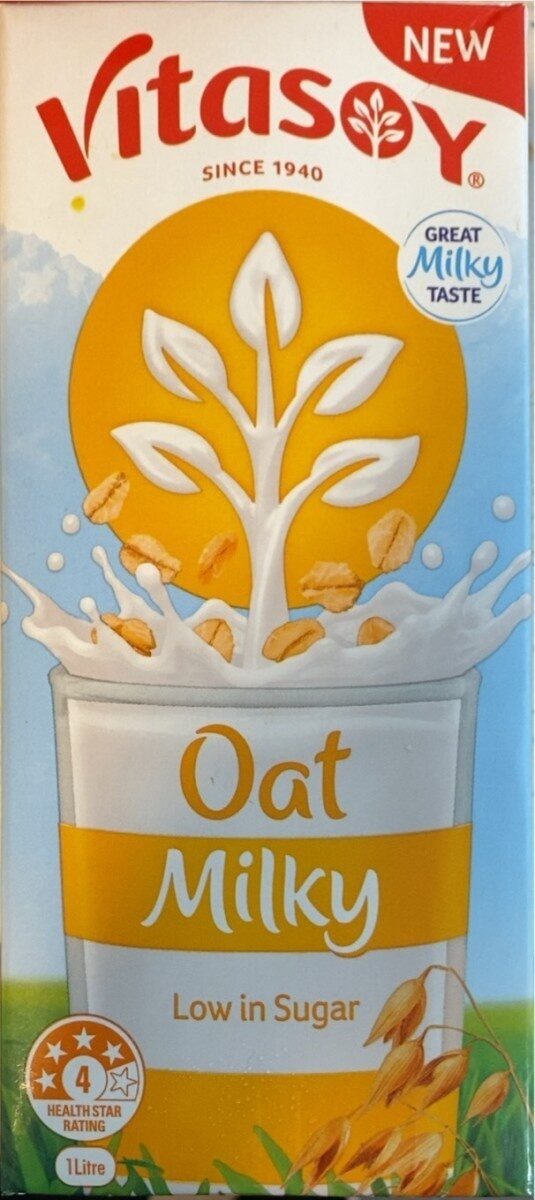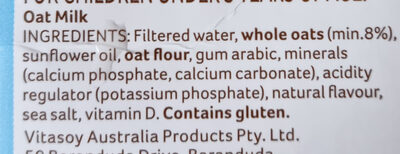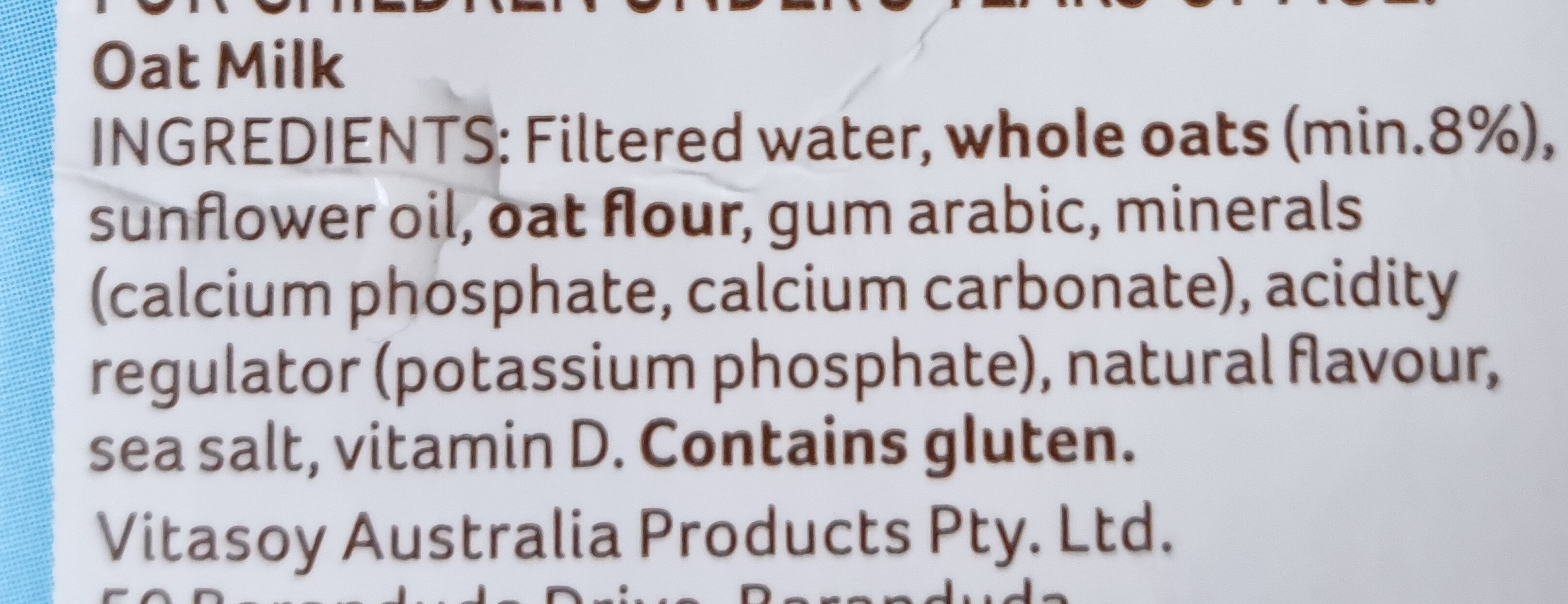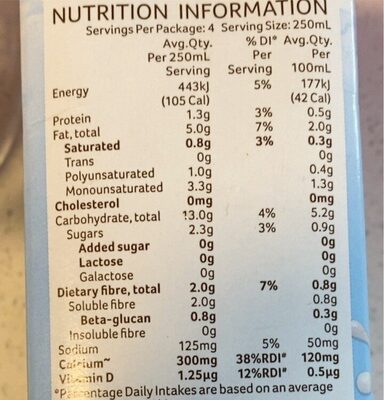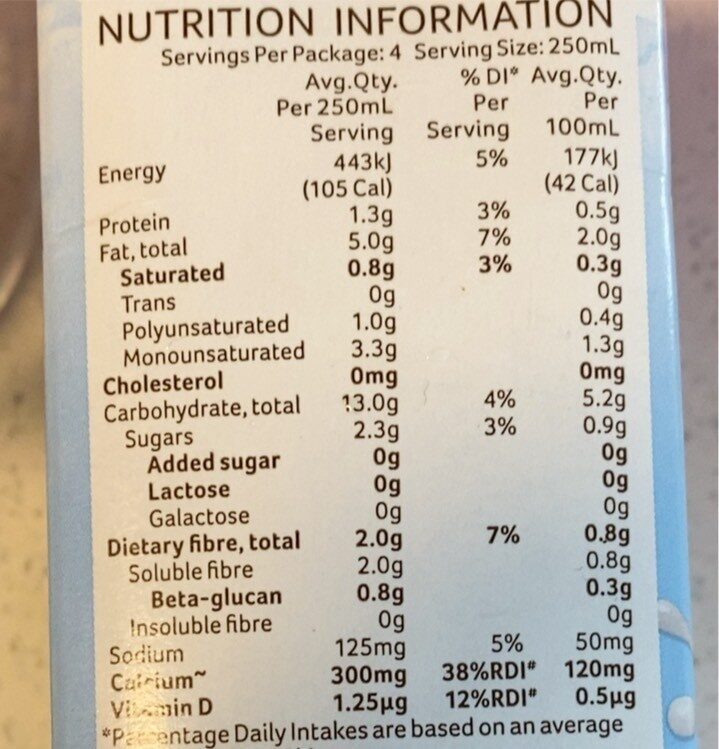Help us make food transparency the norm!
As a non-profit organization, we depend on your donations to continue informing consumers around the world about what they eat.
The food revolution starts with you!
Oat milk - Vitasoy
Oat milk - Vitasoy
This product page is not complete. You can help to complete it by editing it and adding more data from the photos we have, or by taking more photos using the app for Android or iPhone/iPad. Thank you!
×
Barcode: 9341650001599 (EAN / EAN-13)
Brands: Vitasoy
Categories: Beverages and beverages preparations, Plant-based foods and beverages, Beverages, Dairies, Plant-based foods, Cereals and potatoes, Dairy substitutes, Cereals and their products, Milk substitutes, Plant-based beverages, Milks, Plant-based milk alternatives, Cereal-based drinks, Oat-based drinks
Labels, certifications, awards:
Health Star Rating, Health Star Rating 4
Stores: Woolworths, Coles
Countries where sold: Australia, New Zealand
Matching with your preferences
Health
Ingredients
-
16 ingredients
filtered water, whole oats (min.8%), sunflower oil, oat flour, gum arabic, minerals (calcium phosphate, calcium carbonate), acidity regulator (potassium phosphate), natural flavour, sea salt, vitamin d. contains gluten. vitasoy australia products pty. ltd. dudaAllergens: Gluten
Food processing
-
Ultra processed foods
Elements that indicate the product is in the 4 - Ultra processed food and drink products group:
- Additive: E414 - Acacia gum
- Ingredient: Flavouring
Food products are classified into 4 groups according to their degree of processing:
- Unprocessed or minimally processed foods
- Processed culinary ingredients
- Processed foods
- Ultra processed foods
The determination of the group is based on the category of the product and on the ingredients it contains.
Additives
-
E340 - Potassium phosphates
Potassium phosphate: Potassium phosphate is a generic term for the salts of potassium and phosphate ions including: Monopotassium phosphate -KH2PO4- -Molar mass approx: 136 g/mol- Dipotassium phosphate -K2HPO4- -Molar mass approx: 174 g/mol- Tripotassium phosphate -K3PO4- -Molar mass approx: 212.27 g/mol-As food additives, potassium phosphates have the E number E340.Source: Wikipedia
-
E414 - Acacia gum
Gum arabic: Gum arabic, also known as acacia gum, arabic gum, gum acacia, acacia, Senegal gum and Indian gum, and by other names, is a natural gum consisting of the hardened sap of various species of the acacia tree. Originally, gum arabic was collected from Acacia nilotica which was called the "gum arabic tree"; in the present day, gum arabic is collected from acacia species, predominantly Acacia senegal and Vachellia -Acacia- seyal; the term "gum arabic" does not indicate a particular botanical source. In a few cases so‐called "gum arabic" may not even have been collected from Acacia species, but may originate from Combretum, Albizia or some other genus. Producers harvest the gum commercially from wild trees, mostly in Sudan -80%- and throughout the Sahel, from Senegal to Somalia—though it is historically cultivated in Arabia and West Asia. Gum arabic is a complex mixture of glycoproteins and polysaccharides. It is the original source of the sugars arabinose and ribose, both of which were first discovered and isolated from it, and are named after it. Gum arabic is soluble in water. It is edible, and used primarily in the food industry as a stabilizer, with EU E number E414. Gum arabic is a key ingredient in traditional lithography and is used in printing, paint production, glue, cosmetics and various industrial applications, including viscosity control in inks and in textile industries, though less expensive materials compete with it for many of these roles. While gum arabic is now produced throughout the African Sahel, it is still harvested and used in the Middle East.Source: Wikipedia
Ingredients analysis
-
Palm oil free
No ingredients containing palm oil detected
Unrecognized ingredients: Vitasoy-australia-products-pty, Ltd, DudaSome ingredients could not be recognized.
We need your help!
You can help us recognize more ingredients and better analyze the list of ingredients for this product and others:
- Edit this product page to correct spelling mistakes in the ingredients list, and/or to remove ingredients in other languages and sentences that are not related to the ingredients.
- Add new entries, synonyms or translations to our multilingual lists of ingredients, ingredient processing methods, and labels.
If you would like to help, join the #ingredients channel on our Slack discussion space and/or learn about ingredients analysis on our wiki. Thank you!
-
Vegan status unknown
Unrecognized ingredients: Vitamin D, Vitasoy-australia-products-pty, Ltd, DudaSome ingredients could not be recognized.
We need your help!
You can help us recognize more ingredients and better analyze the list of ingredients for this product and others:
- Edit this product page to correct spelling mistakes in the ingredients list, and/or to remove ingredients in other languages and sentences that are not related to the ingredients.
- Add new entries, synonyms or translations to our multilingual lists of ingredients, ingredient processing methods, and labels.
If you would like to help, join the #ingredients channel on our Slack discussion space and/or learn about ingredients analysis on our wiki. Thank you!
-
Vegetarian status unknown
Unrecognized ingredients: Vitamin D, Vitasoy-australia-products-pty, Ltd, DudaSome ingredients could not be recognized.
We need your help!
You can help us recognize more ingredients and better analyze the list of ingredients for this product and others:
- Edit this product page to correct spelling mistakes in the ingredients list, and/or to remove ingredients in other languages and sentences that are not related to the ingredients.
- Add new entries, synonyms or translations to our multilingual lists of ingredients, ingredient processing methods, and labels.
If you would like to help, join the #ingredients channel on our Slack discussion space and/or learn about ingredients analysis on our wiki. Thank you!
-
Details of the analysis of the ingredients
We need your help!
Some ingredients could not be recognized.
We need your help!
You can help us recognize more ingredients and better analyze the list of ingredients for this product and others:
- Edit this product page to correct spelling mistakes in the ingredients list, and/or to remove ingredients in other languages and sentences that are not related to the ingredients.
- Add new entries, synonyms or translations to our multilingual lists of ingredients, ingredient processing methods, and labels.
If you would like to help, join the #ingredients channel on our Slack discussion space and/or learn about ingredients analysis on our wiki. Thank you!
en: filtered water, whole oats 8%, sunflower oil, oat flour, gum arabic, minerals (calcium phosphate, calcium carbonate), acidity regulator (potassium phosphate), natural flavour, sea salt, vitamin d, vitasoy australia products pty, ltd, duda- filtered water -> en:filtered-water - vegan: yes - vegetarian: yes - ciqual_food_code: 18066 - percent_min: 46.375 - percent_max: 92
- whole oats -> en:wholemeal-oat - vegan: yes - vegetarian: yes - ciqual_food_code: 9310 - percent_min: 8 - percent: 8 - percent_max: 8
- sunflower oil -> en:sunflower-oil - vegan: yes - vegetarian: yes - from_palm_oil: no - ciqual_food_code: 17440 - percent_min: 0 - percent_max: 8
- oat flour -> en:oat-flour - vegan: yes - vegetarian: yes - ciqual_food_code: 9310 - percent_min: 0 - percent_max: 8
- gum arabic -> en:e414 - vegan: yes - vegetarian: yes - percent_min: 0 - percent_max: 8
- minerals -> en:minerals - percent_min: 0 - percent_max: 8
- calcium phosphate -> en:e341 - vegan: yes - vegetarian: yes - percent_min: 0 - percent_max: 8
- calcium carbonate -> en:e170i - vegan: maybe - vegetarian: maybe - percent_min: 0 - percent_max: 4
- acidity regulator -> en:acidity-regulator - percent_min: 0 - percent_max: 8
- potassium phosphate -> en:e340 - vegan: yes - vegetarian: yes - percent_min: 0 - percent_max: 8
- natural flavour -> en:natural-flavouring - vegan: maybe - vegetarian: maybe - percent_min: 0 - percent_max: 5
- sea salt -> en:sea-salt - vegan: yes - vegetarian: yes - ciqual_food_code: 11082 - percent_min: 0 - percent_max: 0.125
- vitamin d -> en:vitamin-d - percent_min: 0 - percent_max: 0.125
- vitasoy australia products pty -> en:vitasoy-australia-products-pty - percent_min: 0 - percent_max: 0.125
- ltd -> en:ltd - percent_min: 0 - percent_max: 0.125
- duda -> en:duda - percent_min: 0 - percent_max: 0.125
Nutrition
-
Good nutritional quality
⚠ ️Warning: the amount of fiber is not specified, their possible positive contribution to the grade could not be taken into account.⚠ ️Warning: the amount of fruits, vegetables and nuts is not specified on the label, it was estimated from the list of ingredients: 0This product is not considered a beverage for the calculation of the Nutri-Score.
Positive points: 0
- Proteins: 0 / 5 (value: 0.5, rounded value: 0.5)
- Fiber: 0 / 5 (value: 0, rounded value: 0)
- Fruits, vegetables, nuts, and colza/walnut/olive oils: 0 / 5 (value: 0, rounded value: 0)
Negative points: 0
- Energy: 0 / 10 (value: 176, rounded value: 176)
- Sugars: 0 / 10 (value: 0.9, rounded value: 0.9)
- Saturated fat: 0 / 10 (value: 0.3, rounded value: 0.3)
- Sodium: 0 / 10 (value: 50, rounded value: 50)
The points for proteins are counted because the negative points are less than 11.
Nutritional score: (0 - 0)
Nutri-Score:
-
Nutrient levels
-
Fat in moderate quantity (2%)
What you need to know- A high consumption of fat, especially saturated fats, can raise cholesterol, which increases the risk of heart diseases.
Recommendation: Limit the consumption of fat and saturated fat- Choose products with lower fat and saturated fat content.
-
Saturated fat in low quantity (0.3%)
What you need to know- A high consumption of fat, especially saturated fats, can raise cholesterol, which increases the risk of heart diseases.
Recommendation: Limit the consumption of fat and saturated fat- Choose products with lower fat and saturated fat content.
-
Sugars in low quantity (0.9%)
What you need to know- A high consumption of sugar can cause weight gain and tooth decay. It also augments the risk of type 2 diabetes and cardio-vascular diseases.
Recommendation: Limit the consumption of sugar and sugary drinks- Sugary drinks (such as sodas, fruit beverages, and fruit juices and nectars) should be limited as much as possible (no more than 1 glass a day).
- Choose products with lower sugar content and reduce the consumption of products with added sugars.
-
Salt in low quantity (0.125%)
What you need to know- A high consumption of salt (or sodium) can cause raised blood pressure, which can increase the risk of heart disease and stroke.
- Many people who have high blood pressure do not know it, as there are often no symptoms.
- Most people consume too much salt (on average 9 to 12 grams per day), around twice the recommended maximum level of intake.
Recommendation: Limit the consumption of salt and salted food- Reduce the quantity of salt used when cooking, and don't salt again at the table.
- Limit the consumption of salty snacks and choose products with lower salt content.
-
-
Nutrition facts
Nutrition facts As sold
for 100 g / 100 mlCompared to: Oat-based drinks Energy 176 kj
(42 kcal)-21% Fat 2 g -7% Saturated fat 0.3 g +13% Carbohydrates 5.2 g -33% Sugars 0.9 g -69% Fiber ? Proteins 0.5 g -48% Salt 0.125 g +20% Fruits‚ vegetables‚ nuts and rapeseed‚ walnut and olive oils (estimate from ingredients list analysis) 0 %
Environment
-
Eco-Score C - Moderate environmental impact
⚠ ️The full impact of transportation to your country is currently unknown.The Eco-Score is an experimental score that summarizes the environmental impacts of food products.→ The Eco-Score was initially developped for France and it is being extended to other European countries. The Eco-Score formula is subject to change as it is regularly improved to make it more precise and better suited to each country.Life cycle analysis
-
Average impact of products of the same category: B (Score: 72/100)
Category: Oat-based drink, plain, prepacked
Category: Oat-based drink, plain, prepacked
- PEF environmental score: 0.08 (the lower the score, the lower the impact)
- including impact on climate change: 0.54 kg CO2 eq/kg of product
Stage Impact Agriculture
40.8 %Processing
27.1 %Packaging
12.7 %Transportation
14.0 %Distribution
5.4 %Consumption
0.0 %
Bonuses and maluses
-
Missing origins of ingredients information
Malus:
⚠ ️ The origins of the ingredients of this product are not indicated.
If they are indicated on the packaging, you can modify the product sheet and add them.
If you are the manufacturer of this product, you can send us the information with our free platform for producers.
-
Missing packaging information for this product
Malus: -15
⚠ ️ The information about the packaging of this product is not filled in.⚠ ️ For a more precise calculation of the Eco-Score, you can modify the product page and add them.
If you are the manufacturer of this product, you can send us the information with our free platform for producers.
Eco-Score for this product
-
Impact for this product: C (Score: 52/100)
Product: Oat milk - Vitasoy
Life cycle analysis score: 72
Sum of bonuses and maluses: -15
Final score: 52/100
-
Carbon footprint
-
Equal to driving 0.3 km in a petrol car
54 g CO² per 100g of product
The carbon emission figure comes from ADEME's Agribalyse database, for the category: Oat-based drink, plain, prepacked (Source: ADEME Agribalyse Database)
Stage Impact Agriculture
25.6 %Processing
28.1 %Packaging
18.7 %Transportation
24.9 %Distribution
2.7 %Consumption
0.0 %
Packaging
-
Missing packaging information for this product
⚠ ️ The information about the packaging of this product is not filled in.Take a photo of the recycling information Take a photo of the recycling information
Transportation
-
Origins of ingredients
Missing origins of ingredients information
⚠ ️ The origins of the ingredients of this product are not indicated.
If they are indicated on the packaging, you can modify the product sheet and add them.
If you are the manufacturer of this product, you can send us the information with our free platform for producers.Add the origins of ingredients for this product Add the origins of ingredients for this product
Report a problem
-
Incomplete or incorrect information?
Category, labels, ingredients, allergens, nutritional information, photos etc.
If the information does not match the information on the packaging, please complete or correct it. Open Food Facts is a collaborative database, and every contribution is useful for all.
Data sources
Product added on by kiliweb
Last edit of product page on by lcmortensen.
Product page also edited by archanox, charlesnepote, gconstantine, inf, openfoodfacts-contributors, yuka.sY2b0xO6T85zoF3NwEKvlnVKa-jUjTzhBS75vVWg-MypF7KyYc9wu5r9L6s.
